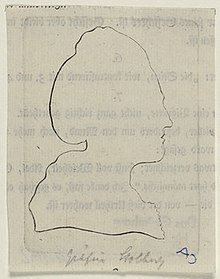Katharina zu Stolberg-Stolberg
Henriette Katharina Countess zu Stolberg-Stolberg (born December 5, 1751 in Bramstedt , † February 22, 1832 in Peterswaldau ) was a German-Danish countess.
Live and act
Katharina zu Stolberg-Stolberg was a daughter of Christian Günther zu Stolberg-Stolberg (1714–1765) and his wife Christiane, née Countess zu Castell-Remlingen (1722–1773). Her brother Christian zu Stolberg-Stolberg was a well-known translator, another brother was Friedrich Leopold zu Stolberg-Stolberg .
Katharina zu Stolberg-Stolberg was considered very eccentric. She had probably inherited this temperament from her mother. Wilhelm von Humboldt described it as "a brouillon as there can only be one on earth". She led an unsteady way of life that cannot be fully traced. She lived as a canoness in the Danish women's monastery Vallø , but traveled a lot and visited friends and relatives on the spur of the moment .
Originally of Protestant faith, she converted to Catholicism in 1802 like her brother, but reversed her decision a little later. Around 1806 she moved to Gut Emkendorf to live with Gottlob Friedrich Ernst Schönborn , whom she had known from earlier . Both lived there in a marriage-like community, but did not get married. After Schönborn's death, Katharina zu Stolberg-Stolberg became a quirky old man who was sometimes malicious.
Katharina zu Stolberg-Stolberg wrote, influenced by Friedrich Gottlieb Klopstock , several sentimental and sensitive stories. In the dialogues there can be found influences from Edward Young , whose translator Johann Arnold Ebert was a friend of his mother's. The literary achievement of Katharina zu Stolberg-Stolberg is insignificant. Her letters and recordings from her youth are important sources for the Emkendorfer Kreis .
literature
- Eduard Jacobs : Stolberg-Stolberg, Katharina, Countess zu . In: Allgemeine Deutsche Biographie (ADB). Volume 36, Duncker & Humblot, Leipzig 1893, pp. 367-370.
- Jürgen Behrens: Stolberg Stolberg, Katharina to . in: Schleswig-Holstein Biographical Lexicon . Volume 1. Karl Wachholtz Verlag, Neumünster 1970, p. 264
Web links
| personal data | |
|---|---|
| SURNAME | Stolberg-Stolberg, Katharina to |
| ALTERNATIVE NAMES | Stolberg Stolberg, Henriette Katharina Countess too |
| BRIEF DESCRIPTION | German-Danish countess |
| DATE OF BIRTH | December 5, 1751 |
| PLACE OF BIRTH | Bramstedt |
| DATE OF DEATH | February 22, 1832 |
| Place of death | Peterswaldau |
